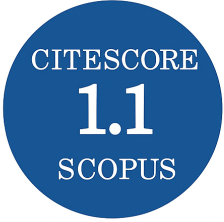Evaluation of Retina Exposition by Optical Incapacitating Device
DOI:
https://doi.org/10.3849/aimt.01284Keywords:
eye model, non-lethal weapon, retina, spot diagramAbstract
It has turned out that the usage of non-lethal weapons is an effective way of tackling adversaries in many security scenarios. The security staff’s goal is to use the lowest possible level of power needed to manage successfully the situation during the conflicts with adversaries. The security staff can employ a wide spectrum of possible reactions beginning with the voice alert through the physical interaction up to the usage of e.g. firearms. The optical incapacitating device is one of possible realizations of non-lethal weapons. Therefore, the article deals with the description of the designed optical incapacitating device and the evaluation of retina exposition when used.
References
TOCCI, N.C., TOCCI, M.D., GERMAN, J.D. and CRAMER, E.C. Enhanced Non-Lethal Visual Security Device. US Patent US6190022, 1995. 17 p.
RUBTSOV, V. LED-based Incapacitating Apparatus and Method. US Patent US7500763, 2005. 30 p.
WOODS, M., BROWN, M., DABNEY M., KING, J. and TONCHEVA, G. Evaluation of ANSI Z136.1-2014 and Comparison with Z136.1-2007 and Z136.8-2012
[online]. In Proceedings of the International Laser Safety Conference. Albuquerque, 2015, 1-10. [viewed 2019-06-09]. Available from: https://www.osti.gov/servlets/purl/1244847
ANSI Z136.1-2007 [online]. American National Standard for Safe Use of Lasers [viewed 2019-06-07]. Available from: https://loci.wisc.edu/sites/default/files/2017-04/American%20National%20Standard%20for%20Safe%20Use%20of%20Lasers.pdf
ALMEIDA, M.S. and CARVALHO, L.A. Different Schematic Eyes and their Accuracy to the in vivo Eye: A Quantitative Comparison Study [online]. Brazilian Journal of Physics, 2007, vol. 37, no. 2A, p. 378-387. https://doi.org/10.1590/S0103-97332007000300008.
GOBBI, P.G. Modeling the Optical and Visual Performance of the Human Eye. Bellingham: SPIE Press, 2013. 430 p. ISBN 978-0-81-949254-8.
LIOU, H.L. and BRENNAN, N.A. Anatomically Accurate, Finite Model Eye for Optical Modeling. Journal of the Optical Society of America A. 1997, vol. 14, no. 8, p. 1684-1695. https://doi.org/10.1364/JOSAA.14.001684.
OPTALIX. Software for Optical Design, Thin-Films and Illumination. Version 10.25 [online]. 2019. [viewed 2019-05-09]. Available from: www.optenso.com
GROSS, H., BLECHINGER, F. and ACHTNER, B. ed. Handbook of Optical Systems, Volume 4: Survey of Optical Instruments. Weinheim: Wiley, 2015. 1092 p. ISBN 978-3-527-69924-7.
Downloads
Published
License
Copyright (c) 2020 Advances in Military Technology

This work is licensed under a Creative Commons Attribution-NonCommercial 4.0 International License.
Authors who publish with this journal agree to the following terms:
1. Authors retain copyright and grant the journal right of first publication with the work simultaneously licensed under a Creative Commons Attribution License that allows others to share the work with an acknowledgement of the work's authorship and initial publication in this journal.
2. Authors are able to enter into separate, additional contractual arrangements for the non-exclusive distribution of the journal's published version of the work (e.g., post it to an institutional repository or publish it in a book), with an acknowledgement of its initial publication in this journal.
3. Authors are permitted and encouraged to post their work online (e.g., in institutional repositories or on their website) prior to and during the submission process, as it can lead to productive exchanges, as well as earlier and greater citation of published work.
Users can use, reuse and build upon the material published in the journal for any purpose, even commercially.






